Showa
16.3 Type 94 Photos
I was given this Showa 16.3 (March, 1941)
Type 94 by an advanced collector who wanted to find a good home for it.

As is typical, the left side is a
bit rougher than the right, since this was the side closest to the body and
hence the one most subject to moisture (i.e. sweat)-induced corrosion. There
are also a couple of light gouges or abrasions in the left grip, especially up
top. The safety at the rear just above the grip works more smoothly and
positively than most of my other Type 94s.
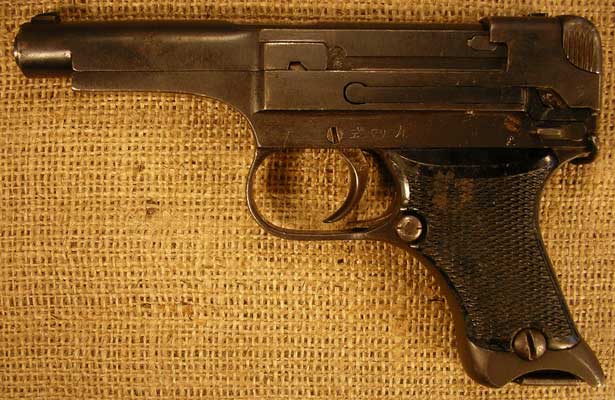
This is a close-up of the main
markings. The symbol before the numbers 16.3 is the character for “Sho”, short for Showa, the name of the era of Emperor Hirohito’s reign. To convert
the number to a Western date, add 1925. Thus, 16 becomes 1925+16=1941. The
number after the decimal place is the month of manufacture (3=the third month,
i.e. March). The markings below this are in reverse order compared to later
pistols. The symbol on the left is the character for south. It is pronounced Nan or
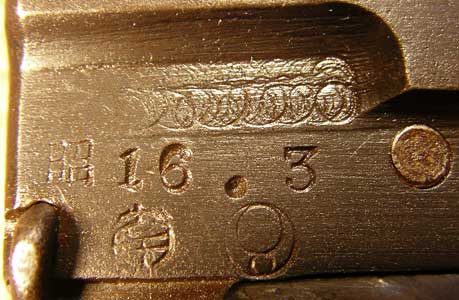
The serial number is further to the
right, above the trigger guard. Off to the left of the serial number is a small
symbol. This is the kanji character to
(as in
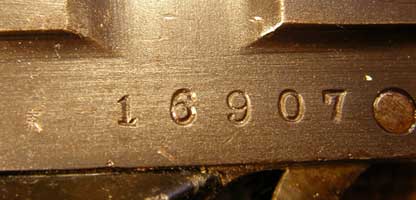
All the numbers on the gun match except
the magazine. The magazine should have the last three digits of the gun’s
serial number (907 in this case,rather than 500). The
magazine is also not the correct type for this pistol. Nickel-plated magazines
were standard until Showa 17.1 (January, 1942). After that they were blued,
like this one. The earliest mags had flat floor plates (until Showa 12.7, or
July, 1939). After that the floor plates were ribbed like this one. The
magazine held six rounds of 8mm Nambu ammunition. The dot above the serial
number on the magazine indicates this was the spare for the gun with which it
was issued. Below the last zero in the date is the kanji symbol “sha”, as in kaisha, or company. This was an inspection mark used by Chuo Kogyo.
It had used N (short for Nambu) until 1941, when the Japanese military
instructed firearms manufacturers to stop using Roman (i.e. English) letters.
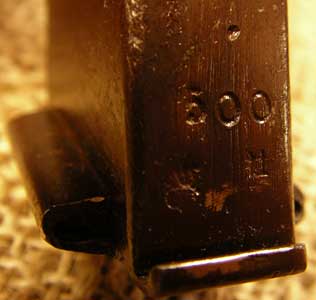
When I got the gun the action was
very sluggish and the exterior finish rather dull. Upon stripping it down, I
could see that the problem was a very minor one: the entire interior and some
of the exterior was covered in very light surface rust and was completely dry
(i.e. no lubrication). Fortunately the problem was in a very early stage, so a
light brushing with ultra-fine 0000 steel wool took
almost all of it off. Then I saturated everything with G-96 gun treatment,
which loosed up the rest and got into all the little cracks and crevices. I
prefer the use of light hand methods like 0000 steel wool to
chemical rust removers, as the latter may keep working longer than you
want. Bluing is in effect a type of oxidization like rust, so anything that
will remove rust will also remove bluing. This photo shows the upper part of
the magazine well from the left side, with the gun upside down. In the lower
right corner you can just make out the model number markings: kyu-yon-shiki, or Type 94. In the
upper-centre of the photo is part of the magazine safety, with the back of the trigger
itself off to the right. This was one of the spots where the rust was most
visible, although it was everywhere.
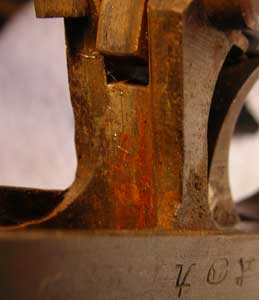
Here is the bolt. The dull, dirty
look was also due to that light rust. The oval-shaped hole is for the
crossbolt. It fits into a recess in the bottom of the firing pin and holds the
bolt to the slide. The bolt looks much better now.
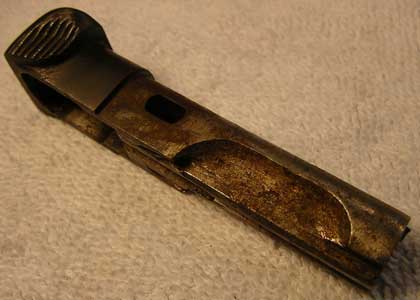
There is some pitting on the left side of the barrel
housing (“slide”), both right near the muzzle and a little further back.

There is also some towards the rear on
the left side. This shot shows the front of the bridge in the frame into which
the barrel housing (“slide”) fits. Here you can see the other side of the
crossbolt, which has a little tab on it so it can be removed from the left, but
not from the right.
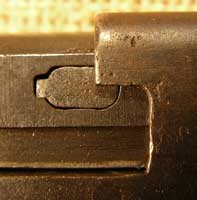
Click here to go back to the Type 94 Photo
Gallery: Type 94 Photo
Gallery
Click here to go back to Nambu World: Teri’s
WWII Japanese Handgun home page: Nambu World: Teri’s WWII Japanese
Handgun Website
Last updated: November 9, 2005. All contents are copyright Teri
unless otherwise specified and may not be used elsewhere in any form without
prior permission.